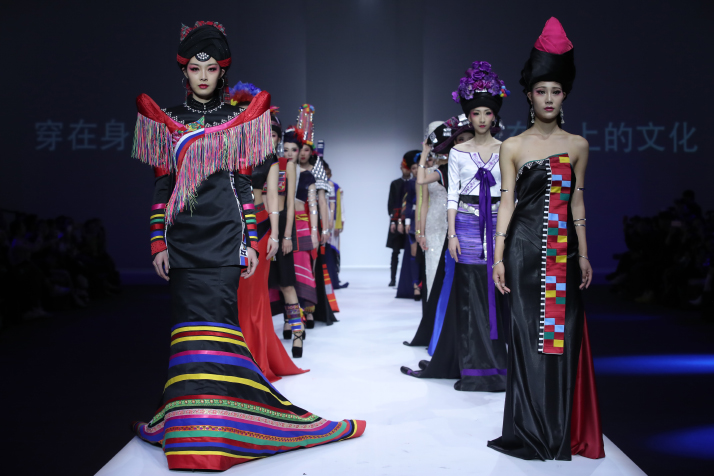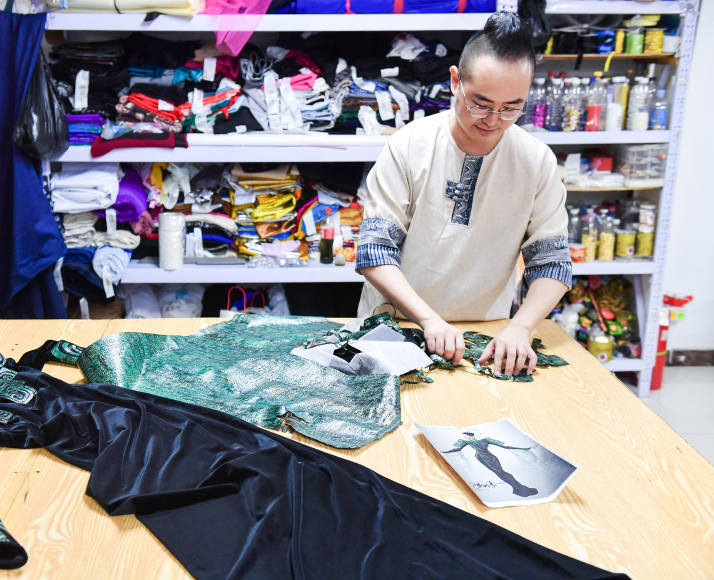| Lifestyle |
| Ethnic clothing and traditional costumes: More than beauty | |
|
|
 Models wear Zhang Kejia's designs at a fashion show during China Fashion Week 2019 in Beijing (COURTESY PHOTO)
2017, the Moulin Rouge, Paris. A young Chinese man dressed in a traditional Miao costume was stopped by a doorman because the theater dress code recommends "elegant attire." "What I'm wearing is the formal costume of my hometown, the dress code." He explained. The doorman let him in and sighed, "I like your outfit. Where can I buy it?" This young man, Zhang Kejia, is a costume designer. Originally from the Miao ethnic group in Guizhou Province, he first dabbled in film and television design before pursuing further fashion studies in France. The 33-year-old has been forging a deeper connection with his Miao identity ever since that night at the Moulin Rouge. He has been exploring the integration of traditional mysticism and the modernity of the world. "We do have our own attires to showcase etiquette within the ethnic group. Why not try and make the old into something new to be better adapted to an international setting?" Zhang told Beijing Review. "During many ceremonial or diplomatic events, ethnic costumes are a symbol of tradition. And this is exactly what we want to carry on."  Zhang Kejia at work in his Beijing studio on September 1 (WEI YAO)
Tradition to tassels A blend of designing philosophies with an ethnic twist has thus far inspired several of Zhang's designs, which also build on the theme of diversity. For Zhang, his history-inspired fashionable overhaul may become a good way to further explore the beauty of ethnic traditions. The wonderful thing about Yunnan Province, where he grew up, is that it boasts spectacular natural landscapes, widespread biodiversity and an array of ethnic groups. Among China's 56 ethnic groups, 26 reside in this province, a fruitful foundation for Zhang's fashion design. Creativity has all the space it could possibly desire to flourish. Most people are often baffled by the designs of the traditional ethnic costumes, their original materials, their bright and colorful looks, the "strange" tailoring and the stunning variety of hues. It's all one big splash of fashionable complexity. Zhang's studio is located inside Beijing's Gaobeidian Art Zone. Among the pictures on the wall, one of them is of well-known Pumi singer Rongbaxinna performing in the countryside dressed up in a red and blue dress designed by Zhang. Before finding Zhang, the singer had sought out other designers yet their works were either too modern and lacked original features, or came bearing too many ethnic elements to wear on stage. She wanted a gown that not only featured the characteristics of the national culture, but could also be worn when the dress code veered toward the more formal. In order to design such a dress, Zhang changed his draft several times. "Many ethnic groups have no written history; they literally wear their traditions on the outside," Zhang said, "The best garments must come from the history of this particular group. I did quite a lot of research, instead of just putting elements together in rather ponderous style." The Pumi are a small ethnic group living predominantly in Yunnan. Traditional Pumi costume has three thin lines running down the skirt, representing the sky, the ancestors, and the Pumi people. With his skillful touch, the softness of silk and the firmness of fabric are delicately combined with touches of warm blues and reds. Traditional needlework is embellished by using modern techniques. The design is not limited to the slim-cut, classic Pumi style, but also adopts innovative elements, including a layered look and irregular silhouettes, meaning the dresses can adorn the larger-framed wearer. In 2019, Zhang's debut took to the stage of China Fashion Week and went on to become the most stunning showcase boasting Chinese ethnic clothing culture during the week. Entitled Wearing Culture, a series of charity shows paying tribute to the multi-ethnic costume culture, the eye was on the inheritance of various styles of ethnic clothing through the combination of tradition and fashion. "The show surprised me a lot. I have been studying Chinese ethnic costume culture for many years. The designer has a good taste for the cultural elements of the Chinese ethnic groups. And he injects modern design into this ancient art form," Gao Huibin, the showcase's curator, told Beijing Review. This October, Zhang will unveil his latest collection during SS2022 Shanghai Fashion Week. Through those shows, more people get to know about Zhang and the fashion of dressing in ethnic costumes. "Especially many children in ethnic areas have recognized the charm and the story behind the designs, falling deeper in love with their own costumes," Zhang added. The back story "Don't think of the costumes as dresses simply made from fabric," Zhang said. "Each design has its own story." For him, the Chinese way of expressing beauty is quite implicit. It's more metaphysical; it's a spiritual pursuit channeled by the design. The Lahu people, who mostly dwell in Puer City, Yunnan, has a triangular pattern on their costume, representing dog teeth. "It shows the people's eternal gratitude to and respect for the animal, their loyal friend," Zhang explained. And it's not just about clothing. In the remotest areas of Yunnan, people of the Drung ethnic group, famous for their facial tattoos, to this day incorporate the so-called Drung carpet, symbolizing the seven-colored rays of the sun, in their daily wear. "People there still enjoy the pastoral life, living in harmony with nature," Zhang said. "The carpet is the nation's most primitive worship of nature, as well as its hope for happiness andauspiciousness." "Those beautiful and legendary aspects of ethnic culture should all be seen, known and refreshed, and not just focus on one salute or clothing item," Zhang added. He believes in digging deep into the rich and profound cultural traditions to excavate the different possibilities of traditional ethnic clothing to share with more people. Featuring various subjects ranging from plants to animals, the refined and unique designs of different ethnic groups have been passed down for generations. "Whenever I find myself traveling along a rugged mountain road, I always have a sense of responsibility. We should take those amazing cultures out of the mountains and into the world's fashion industry. This is what we are doing now," Gao said. This year, Zhang has created a new edition of the Wearing Culture show tapping into the story of the mysterious ancient Dian Kingdom, which flourished more than 2,000 years ago in Yunnan. "The show involves the traditional Dai, Miao and Va elements, as well as integrates many ethnic intangible heritage skills," Gao said. At the same time, because of the uniqueness of the ancient Dian culture itself, the time and space involved are even greater. The designer states he wants to contribute to the protection and continuation of ethnic cultures by combining fashionable colors and fabrics, putting a modern twist on traditional attire, so as to fit everyday use. Another staple approach of his is to spot the commonalities in cultures, such as the combination of Tibetan clothing and cowboys. Tibetans on the plateau and cowboys in the western United States share some subtle internal connections in their living environment, living conditions and functional requirements. Consequently, Zhang made a combination of the two, aesthetically and practically. "Designers must love life and understand its beauty," Zhang said, "The design of costumes must come from the people." He believes that the meaning behind the culture of each ethnic group is one you can grasp based on respect. First, do a good job of understanding the legacy, then derive a creation from the cultural matrix, forging a brand new expression. Of style. (Print Edition Title: Tradition Gets A New Look) Copyedited by Elsbeth van Paridon Comments to taozihui@bjreview.com |
|
||||||||||||||||||||||||||||
|
